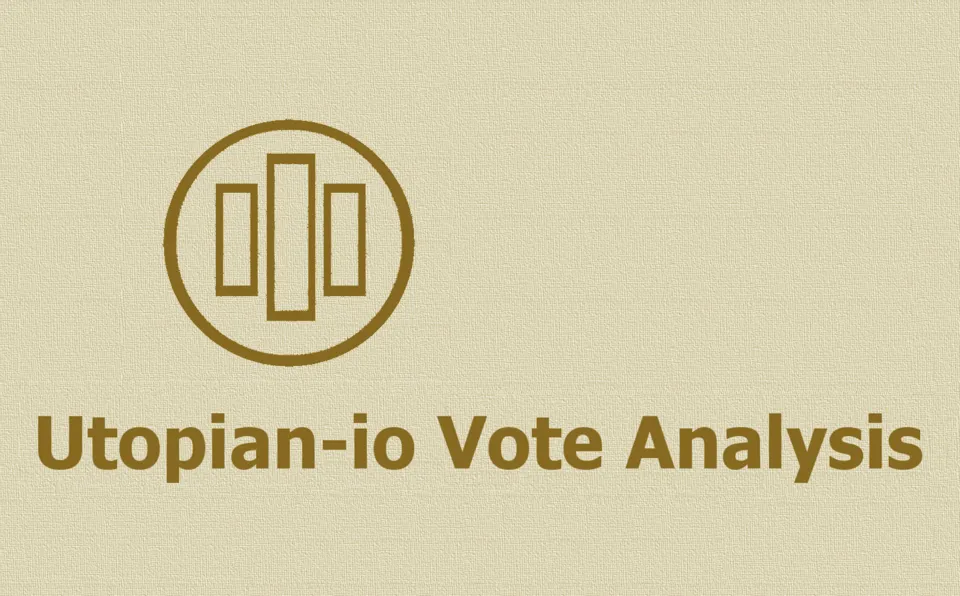
As promised in the December Utopian analysis that I posted last week, here are the corresponding stats for January 2019. This brings me up to date with the Utopian votes analyses. The next monthly instalment will be at the start of February, with normal service resumed.
As usual in this monthly analysis I look at the voting behaviour of Utopian-io across the month and compare to prior months. I aim to:
- Examine the breakdown of votes awarded by category and contribution type;
- Consider numbers of contributors rewarded for each contribution type;
- Review the Utopian vote timing to see whether posts are voted earlier in the seven day payout period; and
- Celebrate another great month for Utopian using some summaries of the top 50 contributors.
1. Allocation of Utopian-io votes by category
These pie charts illustrate how the Utopian-io vote power has been allocated between categories over recent months:
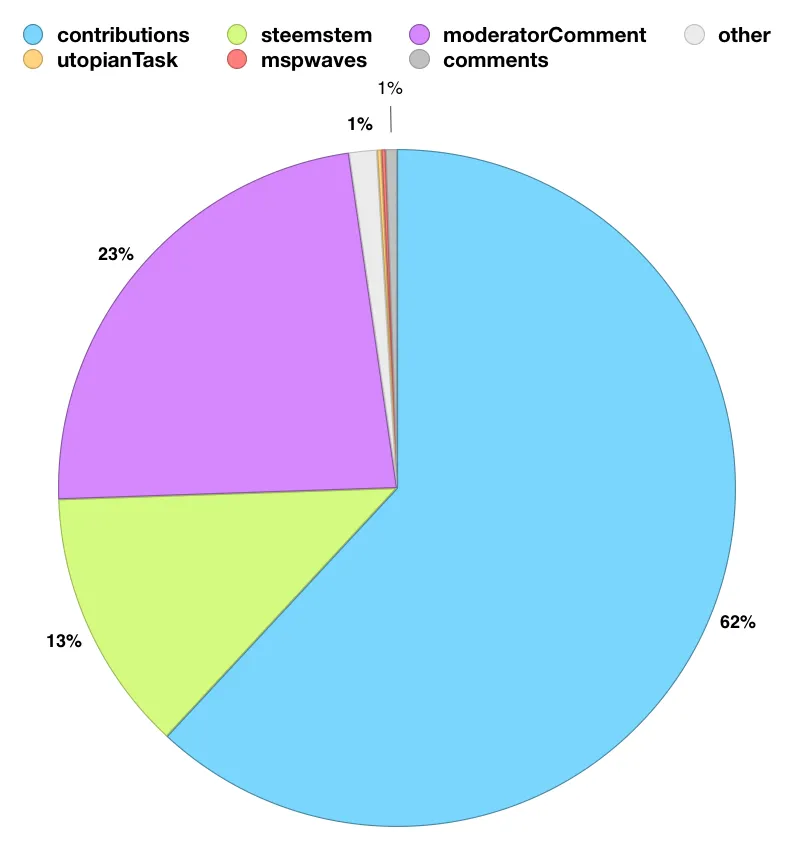 | 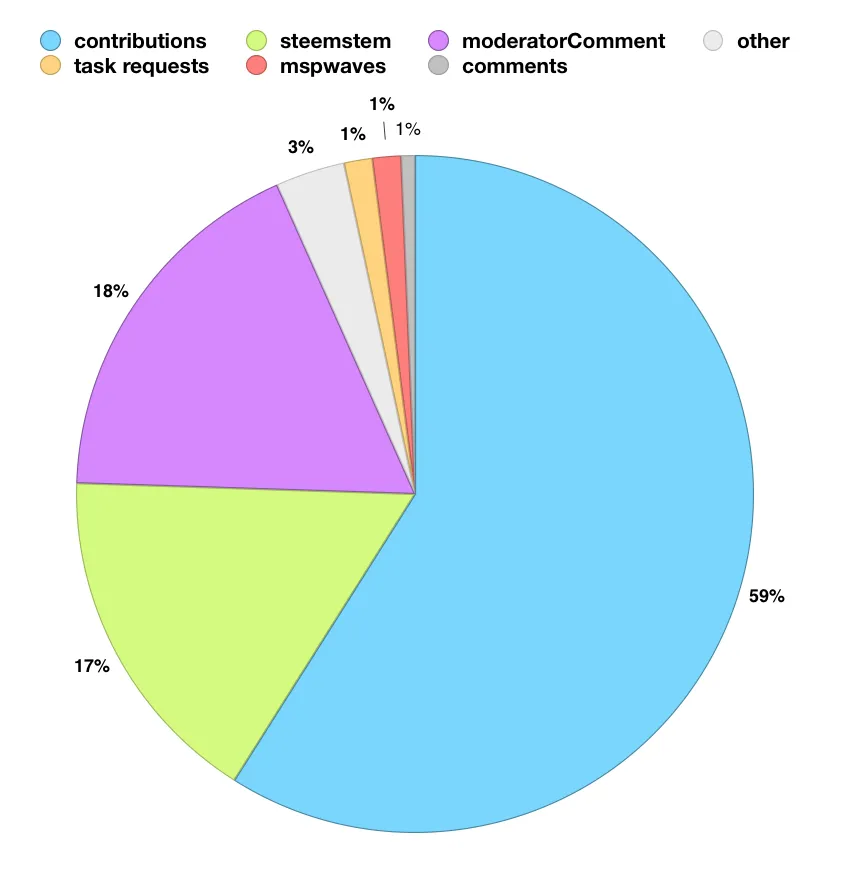 |
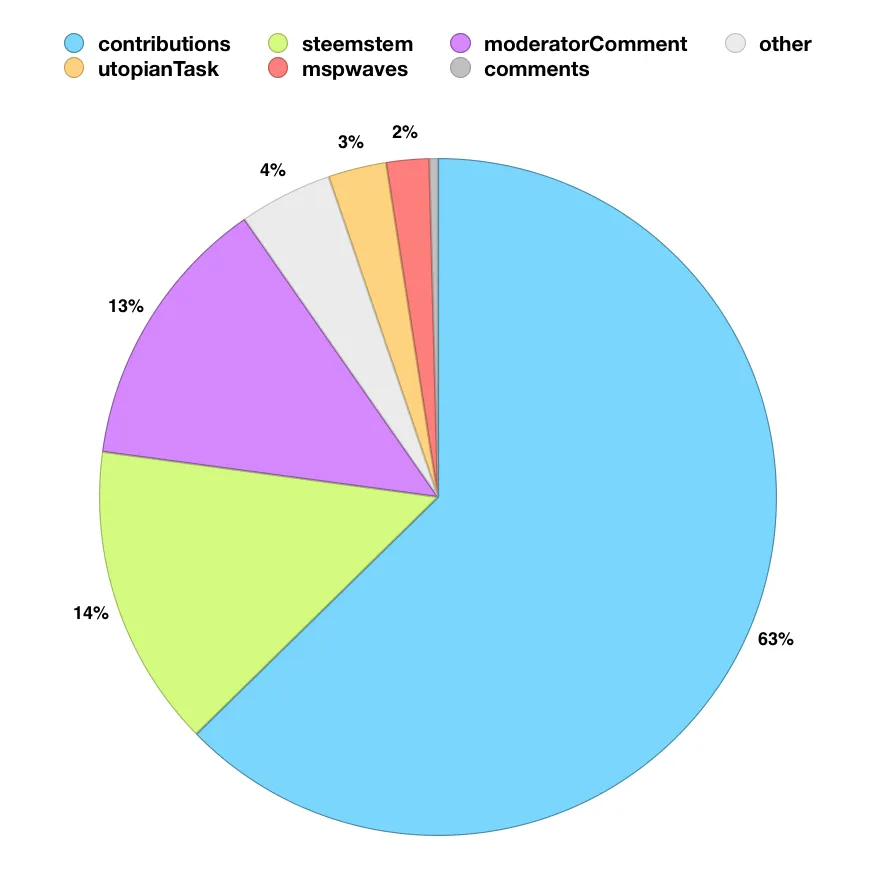 | 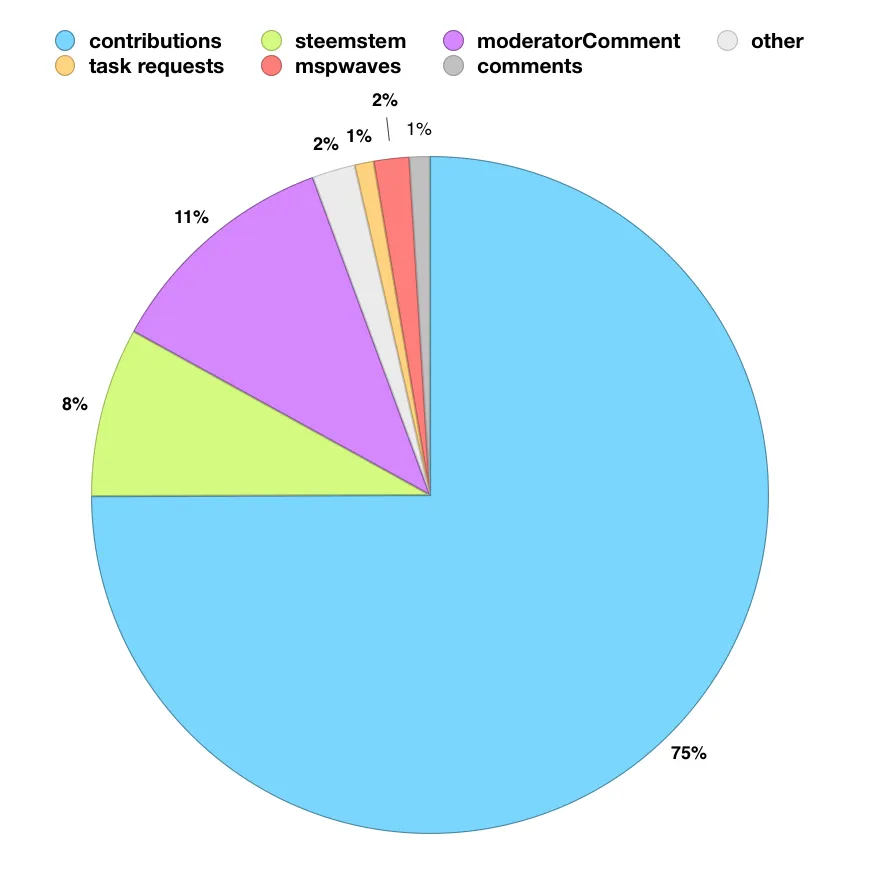 |
The overall contribution percentage (including task requests) for January 2019 was 62%, representing a small rise from the 60% level in December and a halt of the downwards trend in this statistic: October (76%) -> November (66%) -> December (60%).
The main change from December to January was the increase in voting power allocated to moderator comments, a 5% rise from 18% to 23%, matching the corresponding December rise from 13% to 18%. Both these increases arose from a change in the reward structure in mid-December through which moderator rewards were increased to compensate for the significant fall in the Steem price (mid-December was the low point of the bear market). The January increase is simply a "working-through" of this change, representing a full month's impact, whereas for December the impact represented a half-month application of the new structure.
For those new to Utopian a brief explanation of the categories of votes:
- Contributions (blue): Utopian-io mainly rewards contributions to open-source projects. Contributions are not just limited to coding (development) but cover a wide range of technical skills including graphics work, translations, tutorials, copywriting, bugs and ideas.
- Moderator comments (purple): Utopian has a team of over 50 expert moderators who review and score every contribution. Utopian rewards the moderators for their work by voting on their review comments.
- Task requests (yellow): Open source project owners can make requests for work to be carried out on their projects. These take the form of task requests. Only a small number of project owners currently use task requests but they can represent some of the most exciting opportunities for the Utopian community.
- Trails: Utopian-io also supports a number of Steem communities, typically those with links to the open-source world or science and technology. Two of these are separated out in the chart: steemstem (green) and mspwaves (red).
- Other comments and posts (grey): These are one-off votes on posts of high value or interest to the open-source community, such as the arrival of a new project into the Utopian VIPO club. There will also be a few votes that have fallen through the filters I use to determine the category separation.
2. Breakdown of Utopian-io votes by contribution type
This second comparison takes the contribution vote and task request amounts above (blue and yellow segments) and separates them between contribution types for the months in question.
There are fifteen contribution types (fourteen for October, with blog and iamutopian aggregated).
Again, the pie charts to summarise across each month:
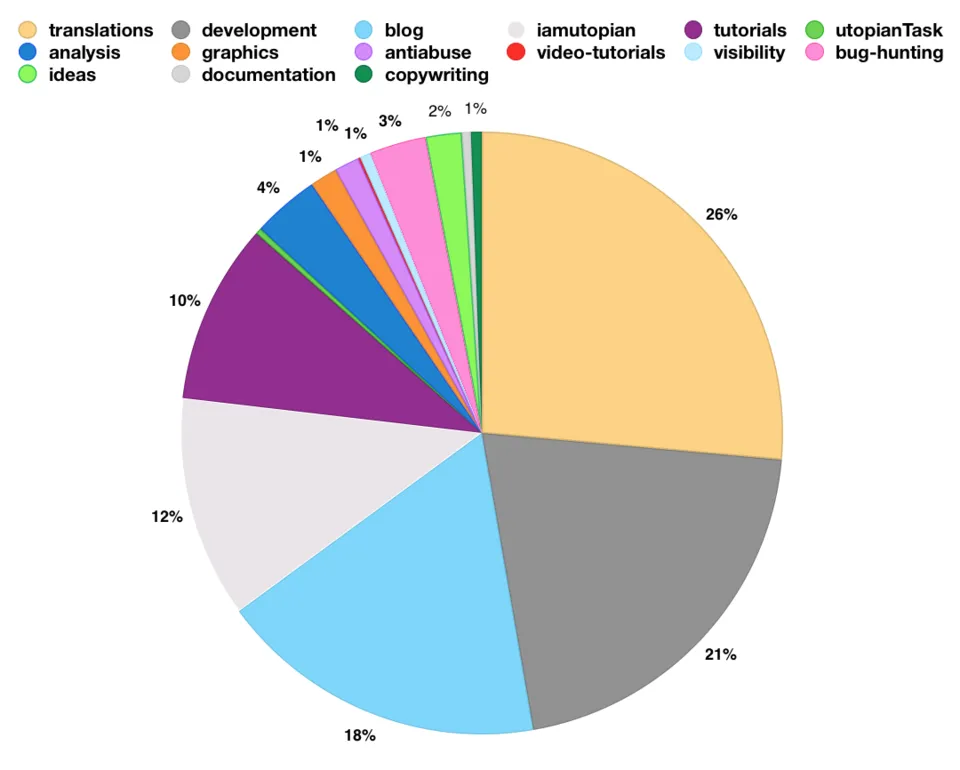 | 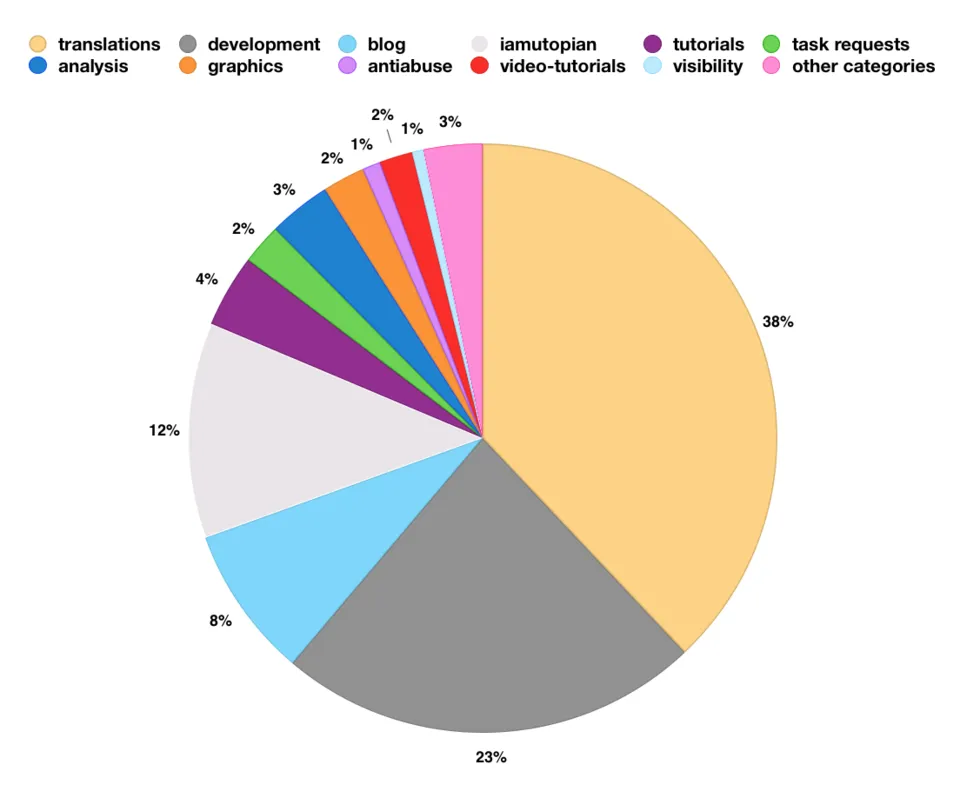 |
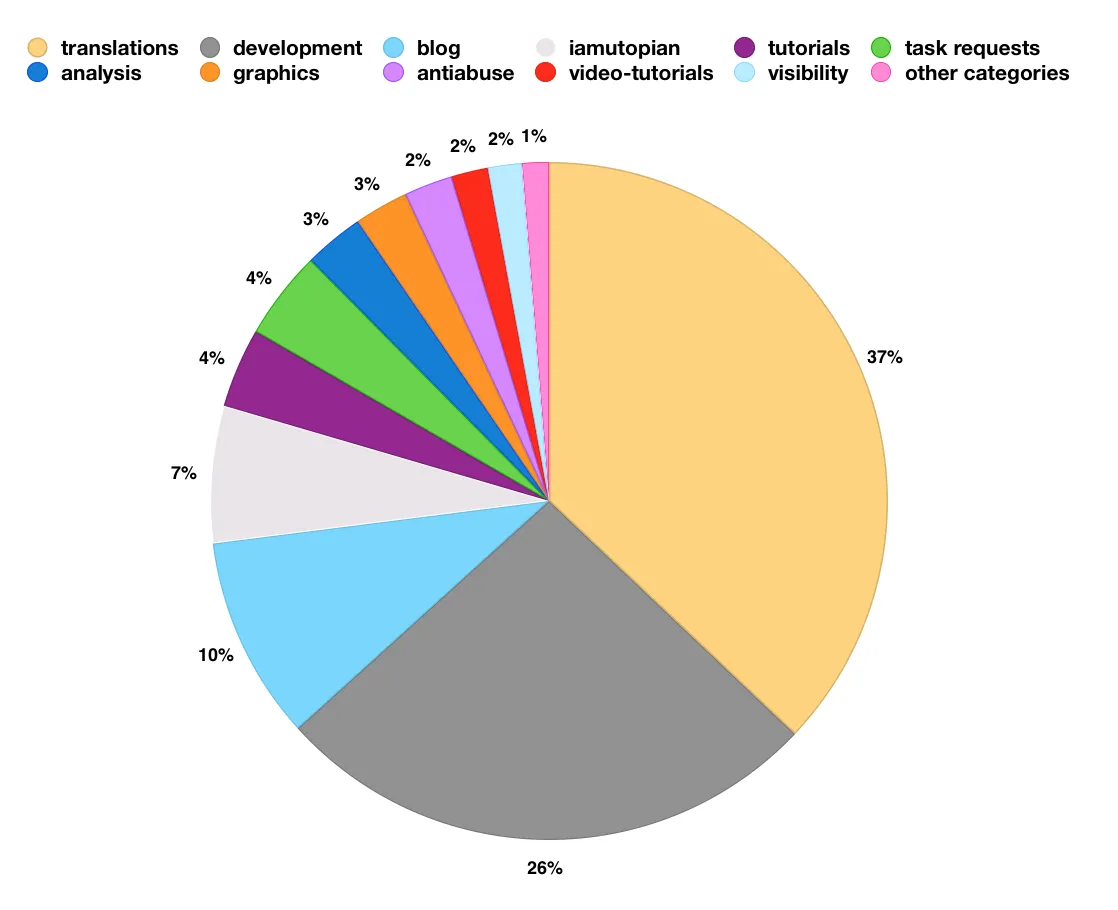 | 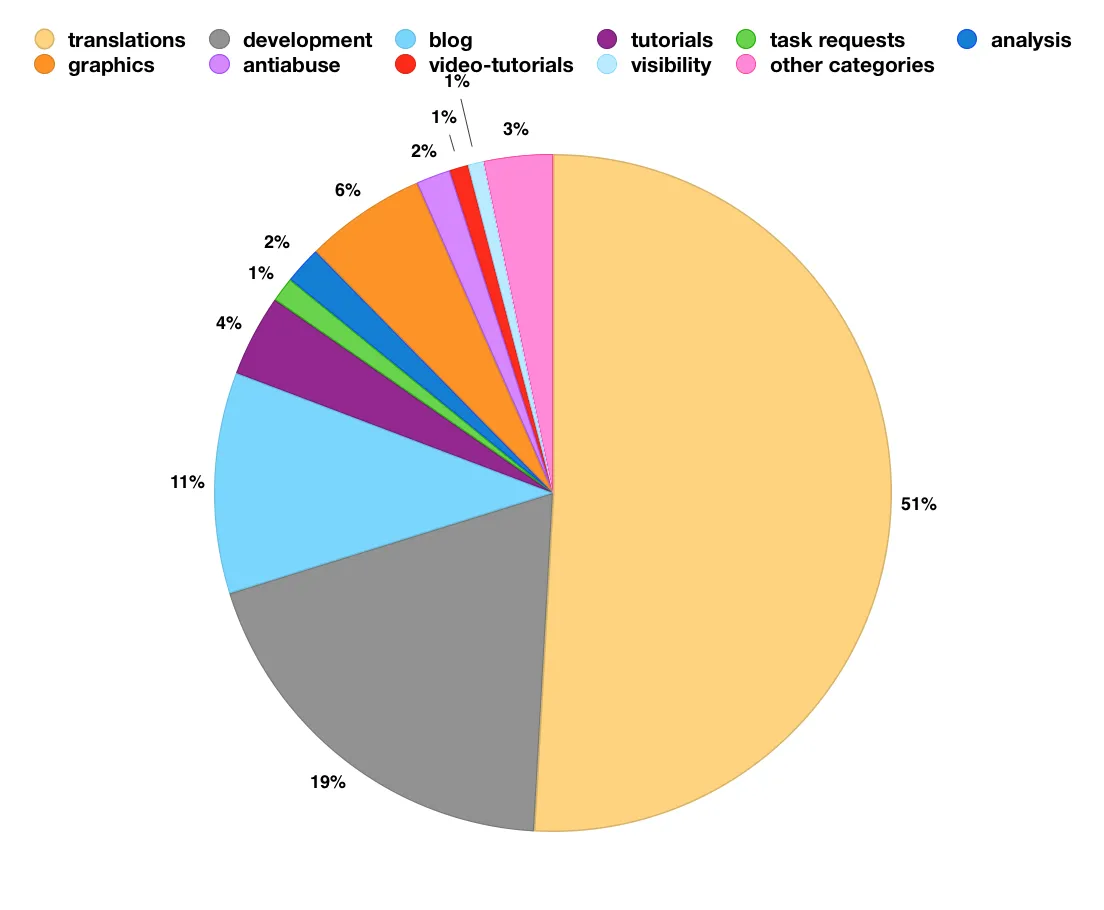 |
While the comparison from November 2018 to December 2018 was very steady, January 2019 represented a significant change in vote allocation. The main movements were:
- Translations, down 12% from 38% to 26%.
- Development, down 2% from 23% to 21%.
- Blog, up 10% from 8% to 18%.
- Tutorials, up 6% from 4% to 10%.
These changes represent a move towards a more even distribution across the largest contribution-types.
With 15 contribution-types the theoretical allocation per contribution bucket is 6.7% (at least I believe that this is how it works). We now have five contribution-types competing for the "surplus" from the ten smaller contribution-types, as well as some increases in the rewards for the smaller contribution-types, reducing the surplus available for the very largest categories.
3. Numbers of contributors rewarded within each contribution type
The following table looks at the number of contributors rewarded by Utopian-io in each contribution type, with a comparison against prior months.
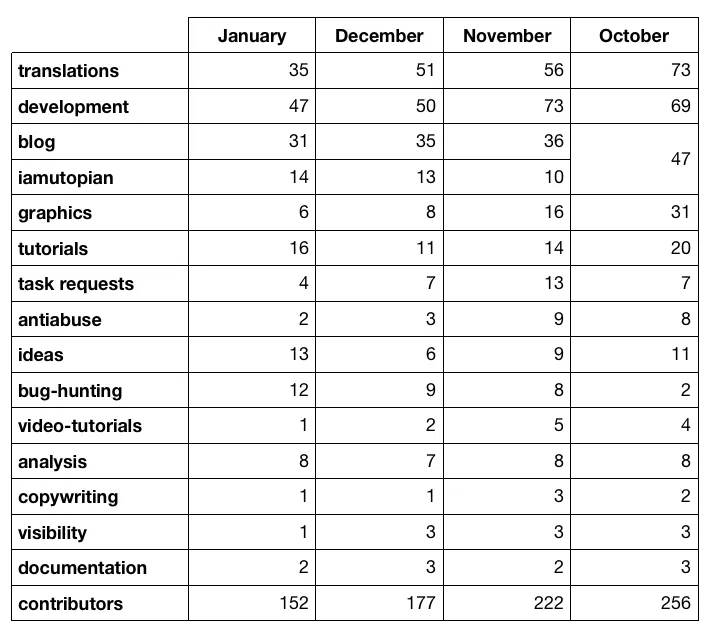
As in December, there has been a general contraction in the number of contributors rewarded by Utopian-io from December to January. This is mainly impacting the Translations category. Based on the pie charts in the section above, it looks like the rewards for translations have been squeezed by other categories, leading to an overall fall in contributors supported.
The are however strong increases in the number of contributors rewarded in tutorials, bug-hunting and ideas. For the latter, the "ideas-hub" initiative may be bringing more ideas-orientated people to Utopian.
4. Utopian-io vote timing
The chart below looks at the timing of votes made by Utopian-io as measured against the seven day voting period for posts.
The y-axis represents the duration in a post’s life at which it is upvoted by Utopian-io. The x-axis shows time across the month.
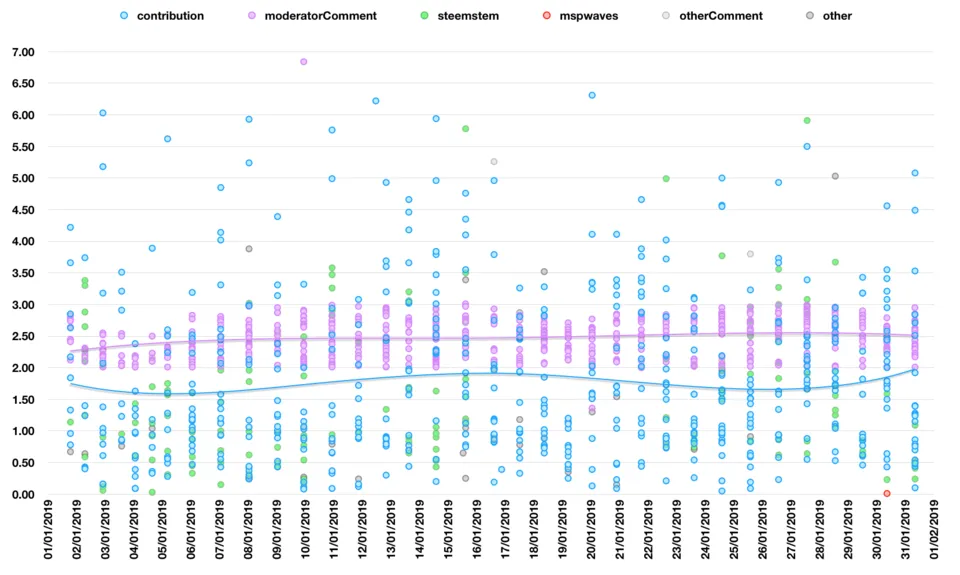
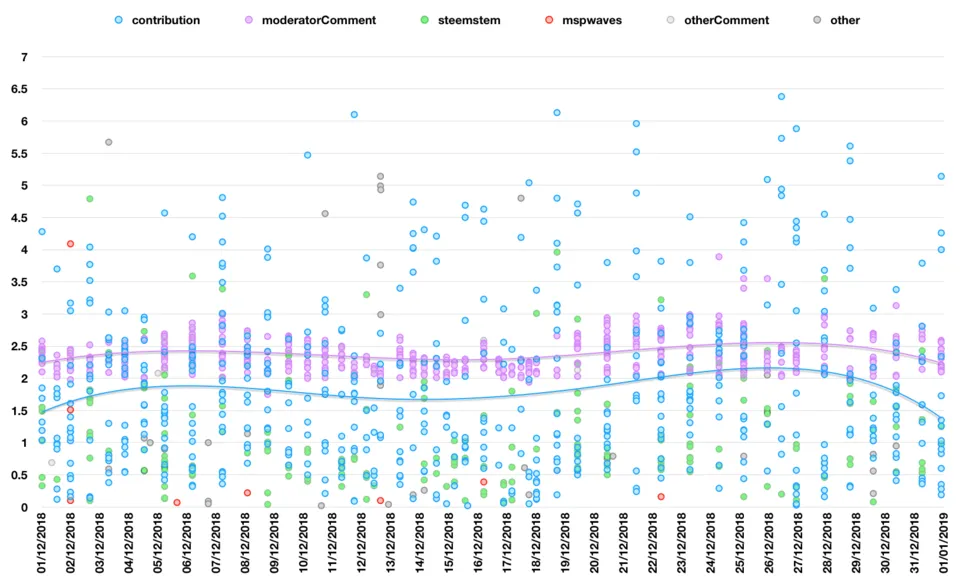
The timing of voting remains steady, with contributions voted on average around the 1.5 - 2 day mark and moderator comments around 2.5 days. Nothing to see here.
5. Summaries of the top 50 Utopian contributors
Congratulations to all those who made it on to the top 50 list for January 2019!
There is an exceptional effort at the top of the rankings. Someone has been working very hard!
A noticeable change from December is that there are now three blog-orientated contributors in the top 15; perhaps not unexpected given the increase in the overall blog contribution rewards that we saw in section 2. And yet more evidence that there are many different ways to successfully contribute to Utopian-io.
January 2019
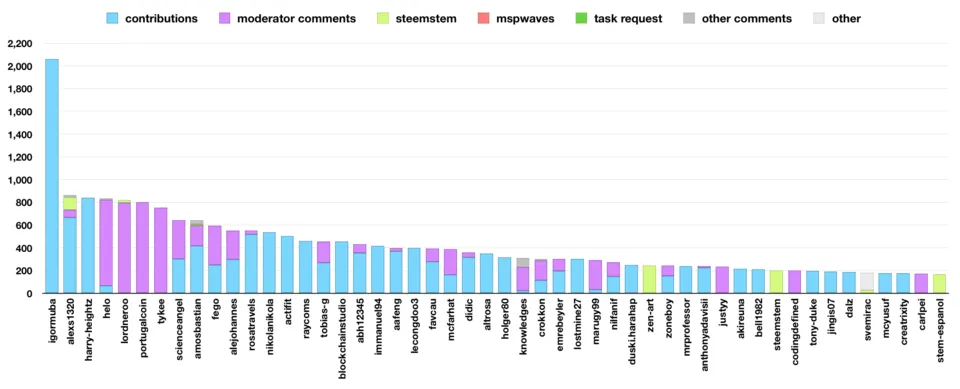
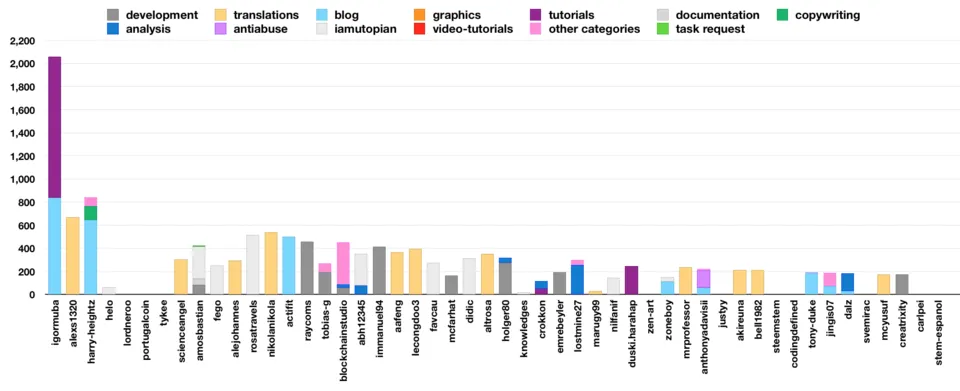
December 2018
December top 50 for comparison.
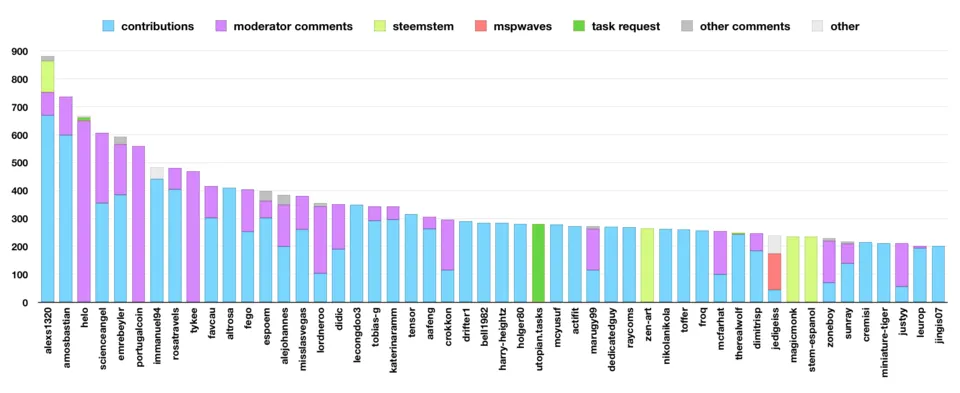
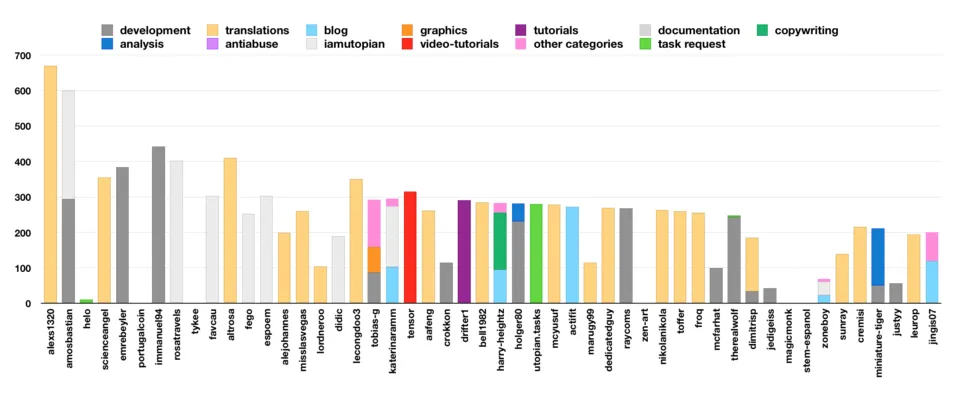
November 2018
November top 50 for comparison.
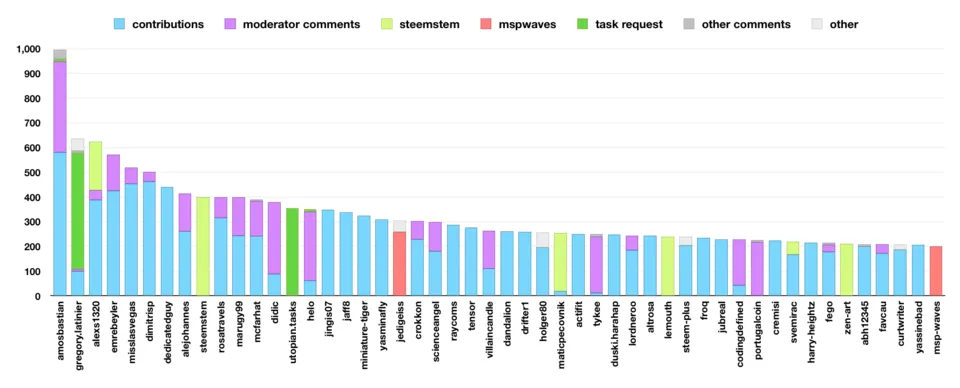
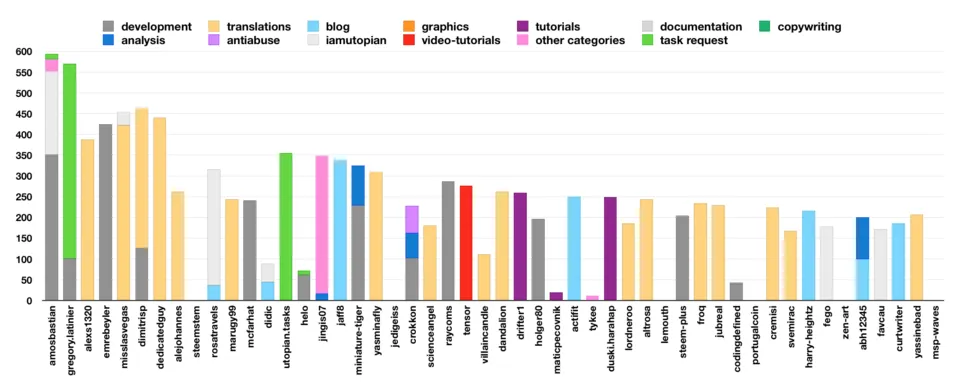
Repository:
This analysis relates to the Utopian open-source project. The relevant repositories are:
- utopian-io/utopian-bot
- utopian-io/utopian.io
Tools and scripts:

I used the block.ops analysis system to produce this study. Block.ops is an open-source analysis tool designed for heavy-duty analyses of the Steem blockchain data.
You can find the repository for block.ops here:
https://github.com/miniature-tiger/block.ops
The analysis used all the Steem blocks from the months analysed. This is approximately 900,000 blocks for each month.
The study can be recreated by:
- Loading the data for the relevant time period into block.ops.
- Using the utopianvotes command from the command line, for example:
$ node blockOps utopianvotes "2018-11-01" "2018-12-01"
As usual, the main difficulty in producing this analysis involved correctly allocating posts to their respective categories and contribution types. This relied entirely on the tags and links included in each post. The order / logic I have used for the allocation is as follows:
- Moderator comments based on having the appropriate links to Utopian guidelines and help.
- Contribution post type based on the tags 'Utopian-io' and the first contribution type that appears. Special consideration taken for idea / ideas and social / visibility.
- Steemstem post based on steemstem vote.
- Task request based on the tags 'Utopian-io' and the first task-contribution type.
- mspwaves post based on msp-waves or mspwaves tag.
- Other posts and comments based on postComment indicator.
Whilst I have made my best effort in this categorisation, I cannot promise to have allocated every post correctly.
Thanks for reading!